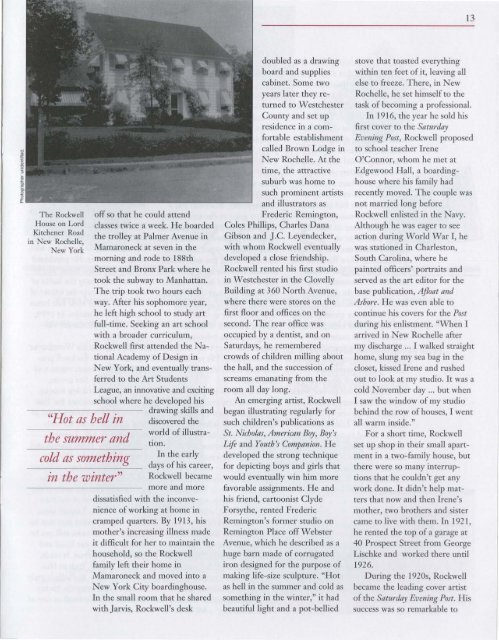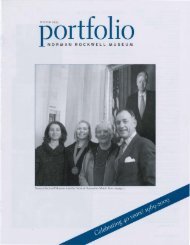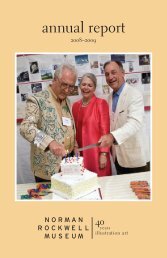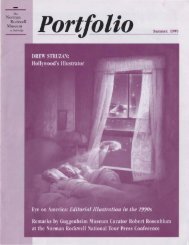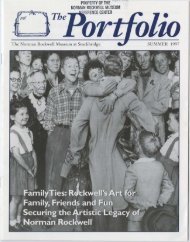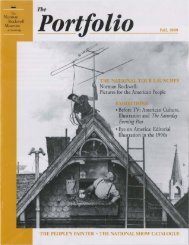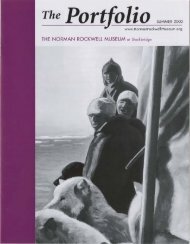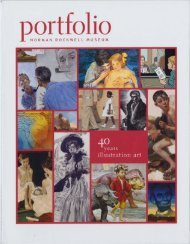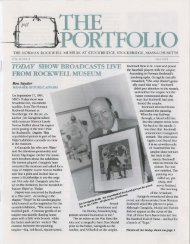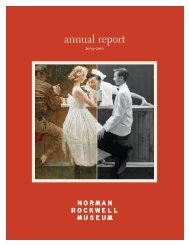Spring 1998 - Norman Rockwell Museum
Spring 1998 - Norman Rockwell Museum
Spring 1998 - Norman Rockwell Museum
You also want an ePaper? Increase the reach of your titles
YUMPU automatically turns print PDFs into web optimized ePapers that Google loves.
13The <strong>Rockwell</strong>House on LordKitchener Roadin New Rochelle,New York"Hot as hell inthe summer andcold as somethingin the winter"off so that he could attendclasses twice a week. He boardedthe trolley at Palmer Avenue inMamaroneck at seven in themorning and rode to 188thStreet and Bronx Park where hetook the subway to Manhattan.The trip took two hours eachway. After his sophomore year,he left high school to study artfull-time. Seeking an art schoolwith a broader curriculum,<strong>Rockwell</strong> first attended the NationalAcademy of Design inNew York, and eventually transferredto the Art StudentsLeague, an innovative and excitingschool where he developed hisdrawing skills anddiscovered theworld of illustration.In the earlydays of his career,<strong>Rockwell</strong> becamemore and moredissatisfied with the inconvenienceof working at home incramped quarters. By 1913, hismother's increasing illness madeit difficult for her to maintain thehousehold, so the <strong>Rockwell</strong>family left their home inMamaroneck and moved into aNew York City boardinghouse.In the small room that he sharedwith Jarvis, <strong>Rockwell</strong>'s deskdoubled as a drawingboard and suppliescabinet. Some twoyears later they returnedto WestchesterCounty and set upresidence in a comfortableestablishmentcalled Brown Lodge inNew Rochelle. At thetime, the attractivesuburb was home tosuch prominent artistsand illustrators asFrederic Remington,Coles Phillips, Charles DanaGibson and ].c. Leyendecker,with whom <strong>Rockwell</strong> eventuallydeveloped a close friendship.<strong>Rockwell</strong> rented his first studioin Westchester in the ClovellyBuilding at 360 North Avenue,where there were stores on thefirst floor and offices on thesecond. The rear office wasoccupied by a dentist, and onSaturdays, he rememberedcrowds of children milling aboutthe hall, and the succession ofscreams emanating from theroom all day long.An emerging artist, <strong>Rockwell</strong>began illustrating regularly forsuch children's publications asSt. Nicholas, American Boy, Boy'sLife and Youth's Companion. Hedeveloped the strong techniquefor depicting boys and girls thatwould eventually win him morefavorable assignments. He andhis friend, cartoonist ClydeForsythe, rented FredericRemington's former studio onRemington Place off WebsterAvenue, which he described as ahuge barn made of corrugatediron designed for the purpose ofmaking life-size sculpture. "Hotas hell in the summer and cold assomething in the winter," it hadbeautiful light and a pot-belliedstove that toasted everythingwithin ten feet of it, leaving allelse to freeze. There, in NewRochelle, he set himself to thetask of becoming a professional.In 1916, the year he sold hisfirst cover to the SaturdayEvening Post, <strong>Rockwell</strong> proposedto school teacher IreneO'Connor, whom he met atEdgewood Hall, a boardinghousewhere his family hadrecently moved. The couple wasnot married long before<strong>Rockwell</strong> enlisted in the Navy.Although he was eager to seeaction during World War I, hewas stationed in Charleston,SOUtll Carolina, where hepainted officers' portraits andserved as the art editor for thebase publication, Afloat andAshore. He was even able tocontinue his covers for tlle Postduring his enlistment. "When Iarrived in New Rochelle aftermy discharge ... I walked straighthome, slung my sea bag in thecloset, kissed Irene and rushedout to look at my studio. It was acold November day ... but whenI saw tlle window of my studiobehind the row of houses, I wentall warm inside."For a short time, <strong>Rockwell</strong>set up shop in their small apartmentin a two-family house, butthere were so many interruptionstllat he couldn't get anywork done. It didn't help mattersthat now and then Irene'smother, two brothers and sistercame to live with them. In 1921,he rented the top of a garage at40 Prospect Street from GeorgeLischke and worked there until1926.During the 1920s, <strong>Rockwell</strong>became the leading cover artistof the Saturday Evening Post. Hissuccess was so remarkable to


